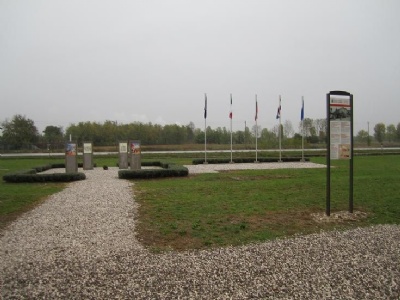Gonars
In a small town called Gonars, just about ten kilometres south of Udine in northeastern Italy, the Italian fascists set up a prisoner-of-war camp for Soviet prisoners of war. However, Soviet prisoners of war were never sent to the camp. Instead it became in spring 1942 a collection camp for yugoslavs who had been arrested in round-ups in and around Ljubljana. At that time, Ljubljana was located in an area incorporated into Italy. Like the Germans, italians also stifle any nationalist tendencies in occupied territories and in many cases used draconian methods to suppress the Yugoslav population. Villages were burned and potential enemies imprisoned or murdered, especially intellectuals because they were considered capable of organizing an underground resistance movement. On the night of 22 and 23 February, 1942, Ljubljana was barred by barbed wire and the Italians arrested the majority of all men. Similar round-ups took alsp place elsewhere.
The camp consisted of three sections called Alpha, Beta and Gamma, and the prisoners were forced to live in both barracks and tents. The camp was built for about 3,000 prisoners but in the summer of 1942 there were about 6,000 prisoners (mostly men). This meant that diseases could spread unrestrained and caused many prisoner’s death. In addition, malnutrition and inadequate food also led to a high mortality. In August 1942, Slovenian resistance fighters managed to escape by digging a tunnel from on barrack to the outside of the camp. After this successful escape, the remaining prisoners were transferred to other camps. Probably because the italians wanted to split up remaining resistance groups. But the camp soon came to be filled with new prisoners, this time with men, women and children arrested in round-ups in Gorski kotar, a mountain region just northeast of Rijeka, Croatia.
In the autumn of 1942, prisoners arrived at Gonars from a camp on the island of Rab just off the Croatian coast. These were in deplorable condition and during the winter of 42/43, about 500 prisoners died as a result of starvation and diseases. About 70 of these were infants. Like all other fascist camps, Gonars ceased to exist in connection with Italy’s capitulation in september 1943. The remaining guards fled and the prisoners were abandoned or released. In the following months, locals demolished the camp to use the material for other buildings. The only thing left of the camp today is the foundations of one of the barracks.
Current status: Demolished with monument (2011).
Location: 45° 54' 26.07" N 13° 14' 10.89" E
Get there: Car.
Follow up in books: Reale, Luigi: Mussolini’s Concentration Camps for Civilians: An Insight into the Nature of Fascist Racism (2011).


Gonars was a Italian fascist camp without any German intervention. Gonars was not the only camp set up by the fascists, the most famous is probably the one on the island of Rab off the Croatian coast. How many of you have heard of it? The fascist camps are far less known than their Nazi counterparts, but that does not mean that those who sat and died in the camps would somehow have suffered less than those who sat in a Nazi camp. But the systematic executions and extreme working conditions prevailing in several of the Nazi camps were far less frequent in the fascist ones. But if Germany has dealt with its Nazi history, perhaps the opposite prevails in Italy. Some trials against former commandants and guards have more or less been non-existent. This is probably due to an unwillingness on the part of the Italian to prosecute and bring any culprits to justice. Mussolini and fascism still have legitimacy and credibility in Italy, which probably makes it problematic to deal with its fascist history.